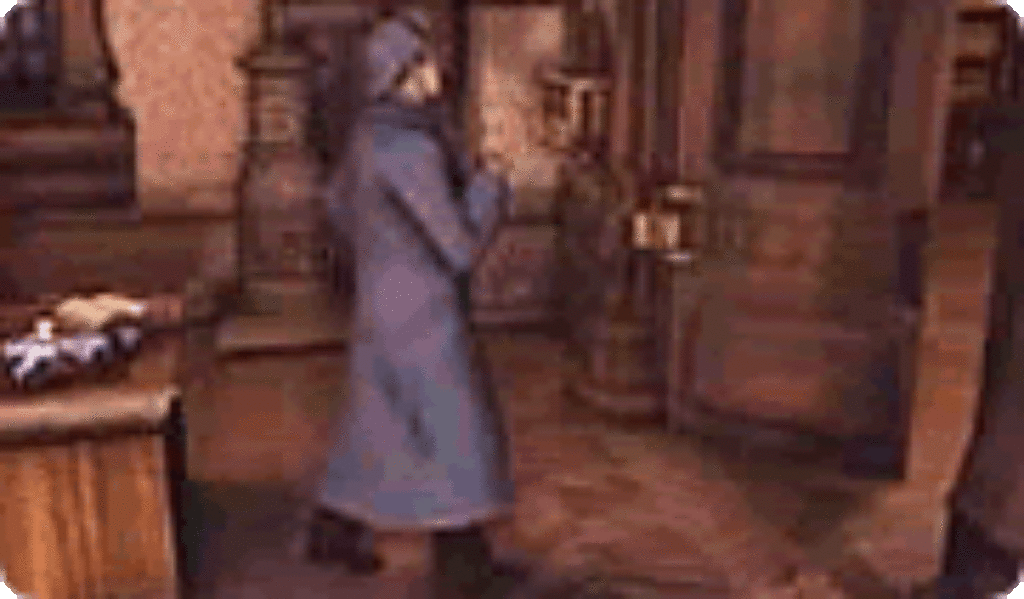
If you’re looking for kid-friendly video games, a clue-solving mystery is generally a pretty safe choice. I haven’t yet seen Nancy Drew pull out an AK-47 to get to the bottom of things. And although Sir Arthur Conan Doyle’s master detective, Sherlock Holmes, does on rare occasions grab a revolver or blade for protection, he’s far better at elucidating than eviscerating.
So let us fetch our deerstalker cap and calabash pipe (a mere prop, of course!) and see how the brilliant bloodhound fares in his newest title, Sherlock Holmes: The Mystery of the Mummy. (I played the Nintendo DS version.)
Watson-less, But Not Clueless
We join Holmes as he’s riding in a London hansom, reading an urgent note from his cousin-to-be, Elisabeth Montcalfe. The young woman is beside herself with worry over her missing—and presumed dead—father. She beseeches the detective to look into the matter. Might he find any clues at Lord Montcalfe’s palatial manor? Sherlock Holmes find clues? Ha. That’s elementary, my dear …
Oops! Faithful sidekick Watson is off on a family vacation. So Holmes decides to go it alone with us looking over his shoulder.
It turns out that Lord Montcalfe is a well-traveled archaeologist and his home is something of a museum, filled with treasures brought back from various expeditions to Egypt. There are ancient tablets, sarcophagi and statues of Egyptian gods all over the place. And as Holmes whips out his magnifying glass and begins his investigation, he finds evidence of stolen antiquities, money-hungry relatives and dour deceit. All surrounded by a slew of potentially deadly traps and what appears to be a mummy’s curse.
A Pity You Couldn’t Find the Pipe Cleaner
Players take on the first-person perspective of the great logician and use the game’s stylus to do just about everything. By pushing an eye icon around the lower screen you can examine every angle and dark corner of the artifact-strewn rooms. And when tapping a hand icon you can move around and pick up objects that look interesting. The game also makes Holmes’ job a bit easier by not letting him pick up anything that won’t, at some point, become useful. That may look like a stray pipe cleaner, but it could be just the thing to dislodge a key from the other side of a locked door.
The upper screen of the DS contains an inventory of the bits and pieces you’ve collected, as well as letters that might give a clue about a puzzle-solving hieroglyph or two. The inventory screen also contains a sketch pad that can be useful to jot down a note or scribble out a diagram as Holmes makes his way from room to room.
If junior detectives become flummoxed when hunting for that missing clock gear or oil can, they can access a built-in clue guide that will nudge them in the right direction—or solve the puzzles altogether if they get frustrated enough. And the truth is, that can easily happen. Not because the word puzzles or timed challenges are so painfully complicated, but because searching for tiny pieces hidden somewhere in a half-dozen rooms crammed onto a small DS screen can be … tedious.
A Half-Finished Holmes
Sherlock Holmes fans will probably expect to be able to use the stylus to connect the dots between hazy clues and colorful deductions. They’ll be disappointed. The story does unfold, but the gaming action in it remains fairly mundane until you reach the very end. That’s when Mr. Holmes elegantly recounts his analysis of the case and how all the clues fit.
I was left scratching my head.
Maybe because small bits of the story and action seem to be missing, and spoken dialogue rarely matches the written script that appears on the screen.
Worth noting: In the midst of that dialogue the word “d–n” is spoken at least once and written twice. The clues also include quite a few mentions of mummy curses, a belief in resurrections and descriptions of various Egyptian gods.
And so, as the game ends and Watson finally shows up—just in time to pat his detecting mentor on the back for another well-solved case—there’s one puzzle that Mystery of the Mummy gamers will most likely still be musing over: Why didn’t I just pick up another one of those nifty Nancy Drew games?

After spending more than two decades touring, directing, writing and producing for Christian theater and radio (most recently for Adventures in Odyssey, which he still contributes to), Bob joined the Plugged In staff to help us focus more heavily on video games. He is also one of our primary movie reviewers.